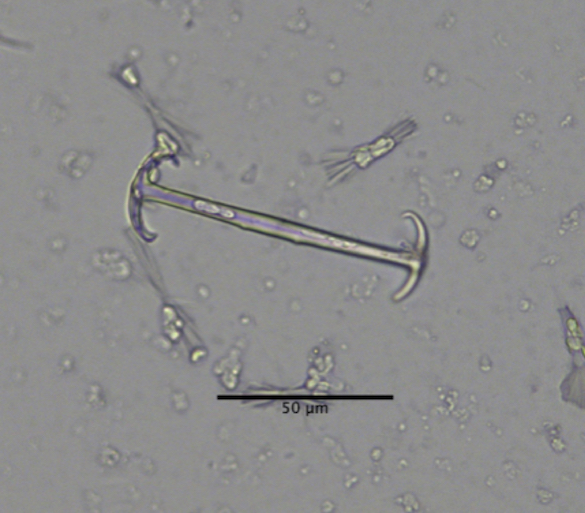54 cm Core from Brown’s Lake Bog Reveals …
 Guest Bloggers: Evie Sanford and Peter Rothstein
Guest Bloggers: Evie Sanford and Peter Rothstein
Summer diatom research continues at The College of Wooster. Building on last summer’s work by Garret Robertson, Minnie Pozefsky and Dr. Mark Wilson, as well as that of other previous IS students Justine Paul Berina and Richard Torres, we have been analyzing the diatom communities at Brown’s Lake. Brown’s Lake is well known among Wooster geology students as the site for many IS projects, research expeditions and class field trips. Located within a Nature Conservancy protected area, the lake is a remnant from glacial ice left behind from retreating glaciers ~15,000 years ago.
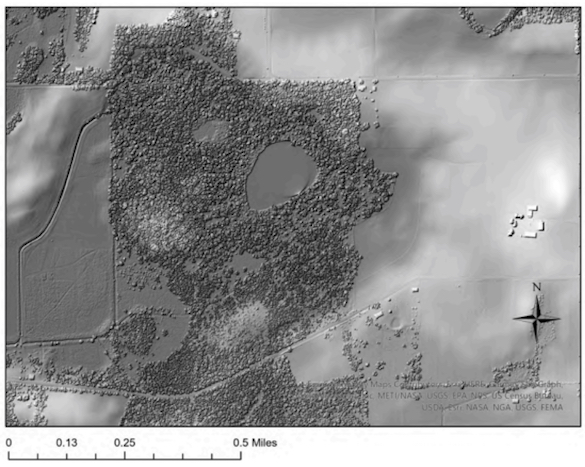 A LIDAR map of Brown’s Lake Bog Nature Preserve.
A LIDAR map of Brown’s Lake Bog Nature Preserve.
After a hot, muddy expedition to the lake in mid-June, we ended up with a sediment core from the edge of the lake. Thanks to Dr. Wiles and Nick Wiesenberg for helping us out with obtaining the core!
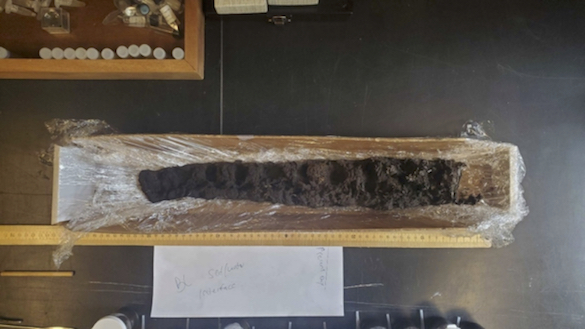 The 54 cm core retrieved from Brown’s Lake.
The 54 cm core retrieved from Brown’s Lake.
The core we ended up with is 54 cm long, and composed of mostly peat. The core has not been dated, but likely extends to around the mid-19th century based on a more silt-heavy composition in the lower sections of the core. Last year’s team was able to match this silt deposition to effects of European-American settlement in the area. Our objective was to further investigate the impacts that this silt deposition and anthropogenic impacts had on diatom communities in Brown’s Lake by surveying their abundances over different depths.
Evie took the lead on making smear slides, following the procedure from Richard Torres’ IS. Taking a sediment sample every 5 centimeters and isolating the silicates. This left behind the diatom skeletons and sponge spicules we wanted to study.
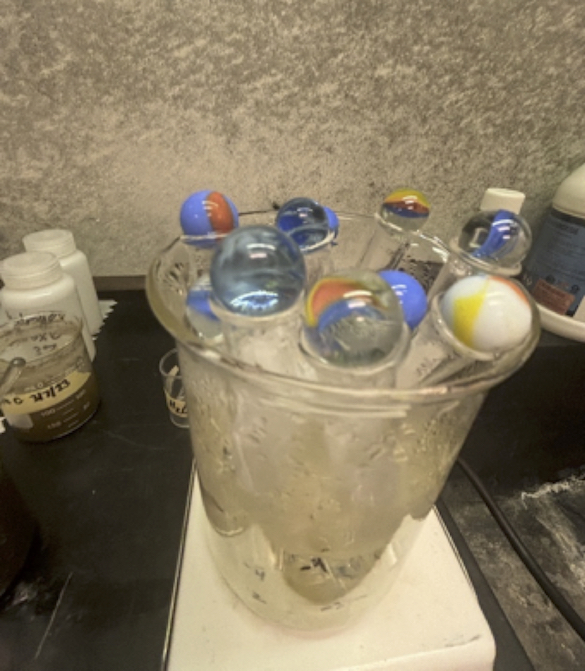 Scientific marbles!! (boiling our hydrogen peroxide and homogenized water-soil sample to kill the organics).
Scientific marbles!! (boiling our hydrogen peroxide and homogenized water-soil sample to kill the organics).
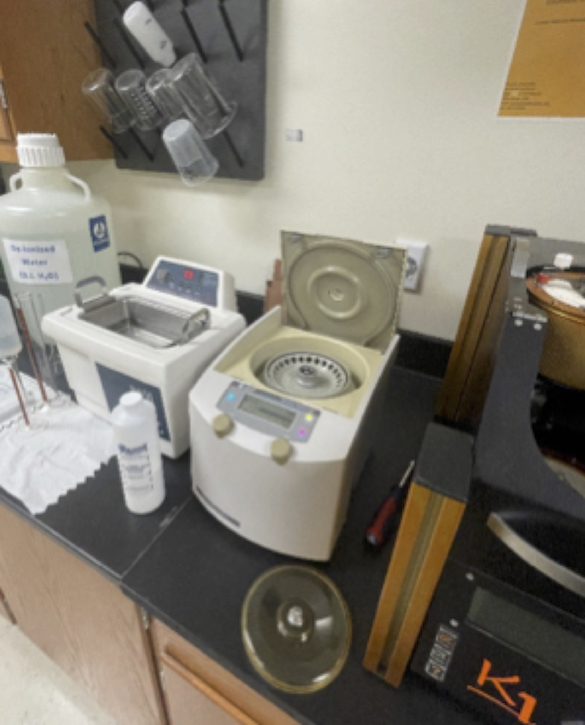 Spinning the samples in the centrifuge to isolate diatoms within the leftover solution.
Spinning the samples in the centrifuge to isolate diatoms within the leftover solution.
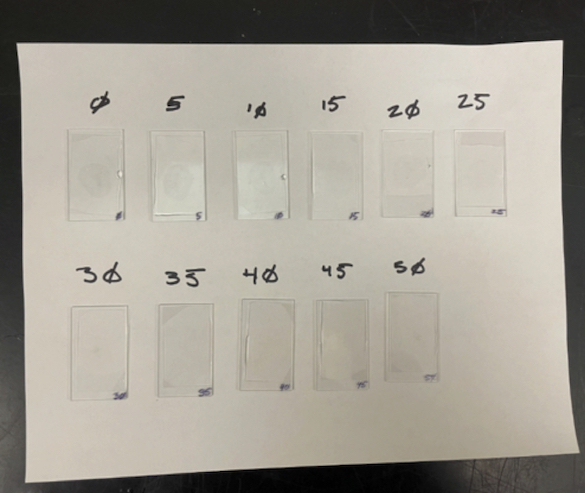 Our slides prepared for inspection.
Our slides prepared for inspection.
After isolating all of the diatoms, we got started on counting them. Peter looked at each smear slide by looking over it 3 times and recording the diatom genera that were intact enough to make an identification. In total 461 individual diatoms and 17 genera were found within the 54 cm core. We found that diatom abundance and diversity peak at a depth of 5 cm to 10 cm and decrease significantly with core depth.
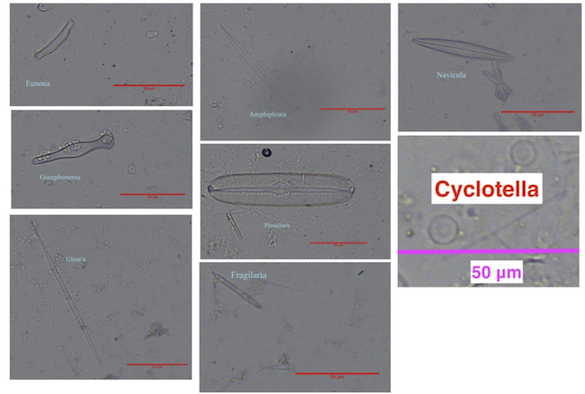 Common diatom genera found in BLB smear slides.
Common diatom genera found in BLB smear slides.
In addition to measuring abundance and diversity of diatoms, we looked at the Biological Condition Gradient of the diatom genera observed. Biological Condition Gradient is a conceptual measurement of ecosystem function/disruption. It ranges from 1-6, with 1 being a wholly natural community structure and 6 being extreme ecosystem disruption. During the section of the core with high silt deposition, Melosira and Navicula are the most common genera. Melosira is largely present in environments with BCG 4 and Navicula are generalists, spread from BCG 1 to 5. However, in the peaty layers near the top of the core, BCG ratings for diatom genera that are usually only present in ecosystems with BCG of 3 or lower. This would indicate that the Brown’s Lake ecosystem has rebounded from the previous environmental disruption.
Diatoms weren’t the only siliceous microfossils present in the core. We also found the occasional sponge spicule:
This core is important to ongoing research at The College of Wooster because it is a subrecent core containing the most recent sediment including diatom skeletons (frustules) and sponge spicules.
Acknowledgements
We thank Nick Wiesenberg for his help both in the field and retrieving the core and instruction in the laboratories. Additionally, we thank Dr. Greg Wiles for his experience and leadership on this project. Previous College of Wooster students Justine Paul Berina, Richard Torres, and Garrett Robertson, as well as Williams College student Minnie Pozefsky, developed and refined many of the techniques used in this work. This investigation was funded by the National Science Foundation grant #2039939.
Source: https://woostergeologists.scotblogs.wooster.edu/2024/07/17/54-cm-core-from-browns-lake-bog-reveals/
Anyone can join.
Anyone can contribute.
Anyone can become informed about their world.
"United We Stand" Click Here To Create Your Personal Citizen Journalist Account Today, Be Sure To Invite Your Friends.
Lion’s Mane Mushroom Nootropic
Mushrooms are having a moment. One fabulous fungus in particular, lion’s mane, may help improve memory, depression and anxiety symptoms. They are also an excellent source of nutrients that show promise as a therapy for dementia, and other neurodegenerative diseases. If you’re living with anxiety or depression, you may be curious about all the therapy options out there — including the natural ones.Our Lion’s Mane WHOLE MIND Nootropic Blend has been formulated to utilize the potency of Lion’s mane but also include the benefits of four other Highly Beneficial Mushrooms. Synergistically, they work together to Build your health through improving cognitive function and immunity regardless of your age. Our Nootropic not only improves your Cognitive Function and Activates your Immune System, But it benefits growth of Essential Gut Flora, further enhancing your Vitality.
Our Formula includes: Lion’s Mane Mushrooms which Increase Brain Power through nerve growth, lessen anxiety, reduce depression, and improve concentration. Its an excellent adaptogen, promotes sleep and improves immunity.
Shiitake Mushrooms which Fight cancer cells and infectious disease, boost the immune system, promotes brain function, and serves as a source of B vitamins.
Maitake Mushrooms which regulate blood sugar levels of diabetics, reduce hypertension and boosts the immune system.
Reishi Mushrooms which Fight inflammation, liver disease, fatigue, tumor growth and cancer. They Improve skin disorders and soothes digestive problems, stomach ulcers and leaky gut syndrome.
Chaga Mushrooms which have anti-aging effects, boost immune function, improve stamina and athletic performance, even act as a natural aphrodisiac, fighting diabetes and improving liver function.
Try Our Lion’s Mane WHOLE MIND Nootropic Blend 60 Capsules Today. Be 100% Satisfied or Receive a Full Money Back Guarantee. Order Yours Today by Following This Link.





